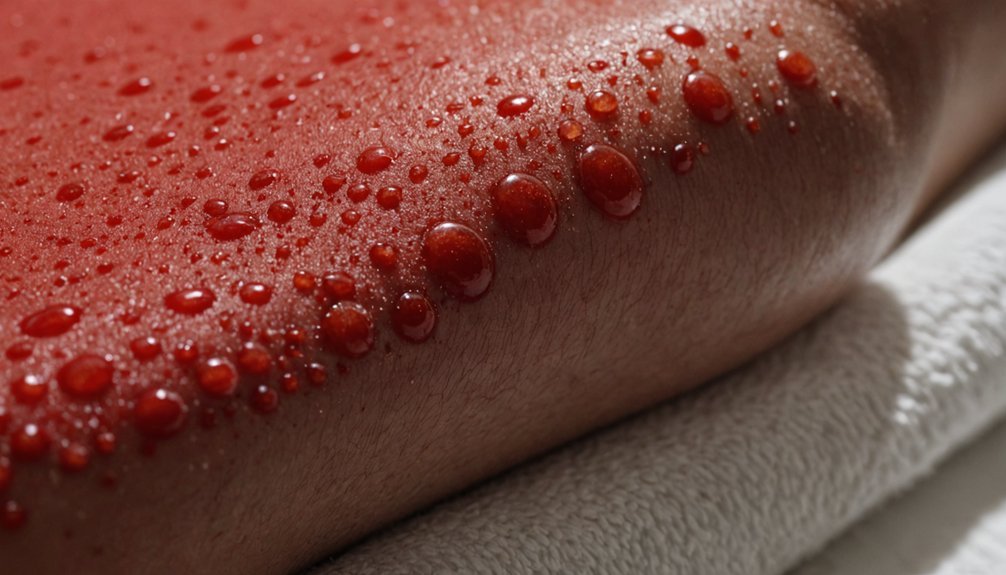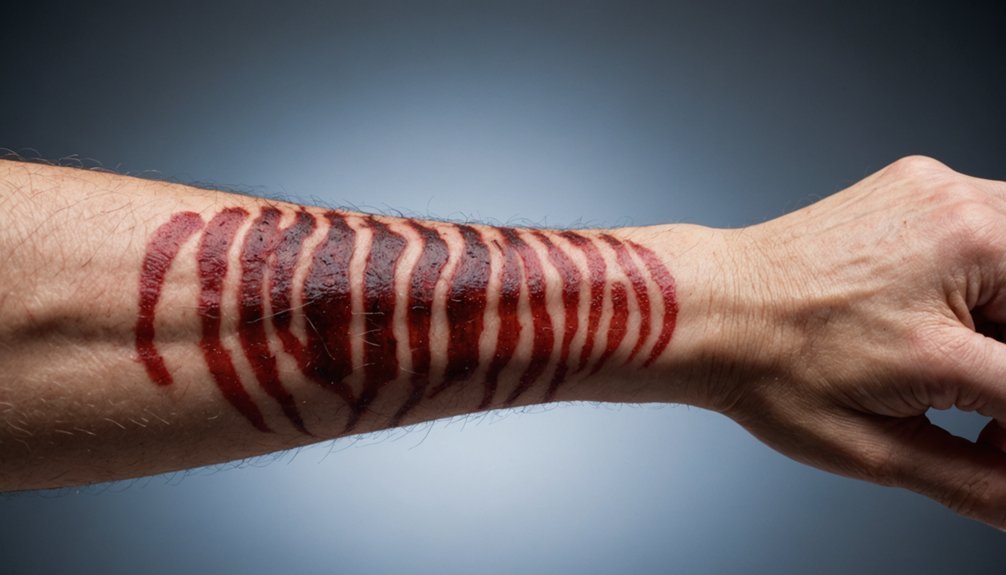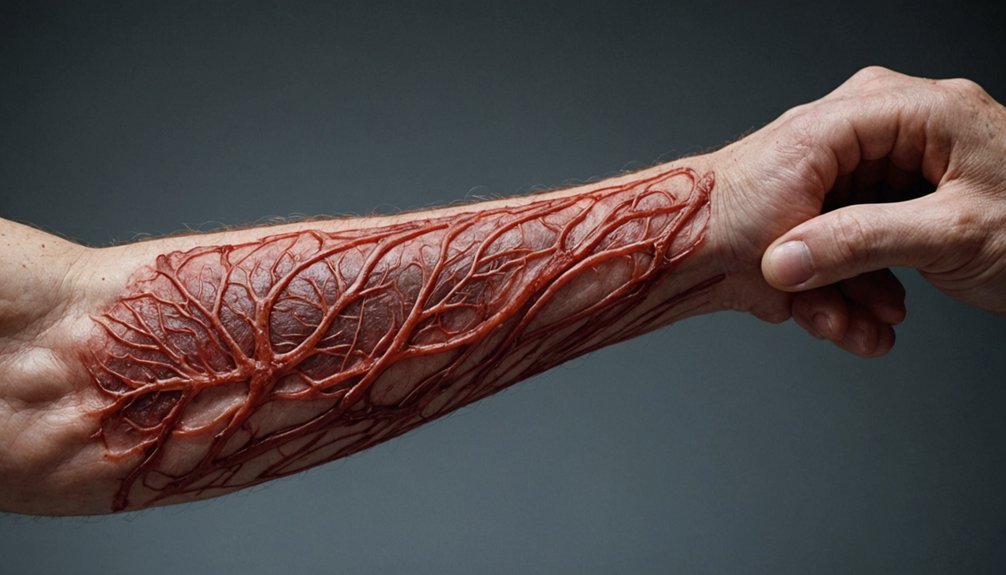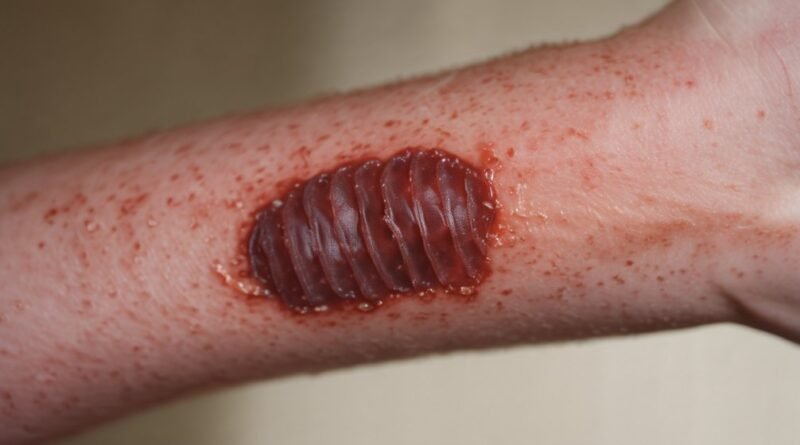Bed Bug Bite Allergic Reactions: Symptoms & Treatment
If you’ve ever woken up with mysterious red welts on your skin, you might be dealing with bed bug bites. While these tiny parasites affect people differently, their bites can trigger allergic reactions ranging from mild itching to severe systemic responses. You’ll want to know exactly what to look for and how to respond, especially since 30% of people experience noticeable symptoms that could worsen without proper treatment.
Key Takeaways
- Most bed bug bites appear as raised red welts or small spots in clusters, primarily affecting the neck, face, arms, and legs.
- Only 20% of people experience allergic reactions to bed bug bites, while up to 70% may show no symptoms at all.
- Severe allergic reactions include extensive blistering, widespread hives, facial swelling, and difficulty breathing, requiring immediate medical attention.
- Treatment for mild reactions includes over-the-counter hydrocortisone cream, oral antihistamines, and cold compresses to reduce inflammation and itching.
- Call 911 immediately if experiencing throat swelling, breathing difficulties, chest pain, or signs of anaphylaxis during a severe reaction.
Understanding Common Allergic Reactions to Bed Bug Bites

While bed bug bites affect people differently, their saliva contains dozens of proteins that can trigger allergic responses in humans. You might notice raised, red welts or small spots less than a quarter inch in size appearing in clusters or lines on your exposed skin. These typically show up on your neck, face, arms, and legs.
Though initial bites may be painless, you’ll likely experience intense itching that can last up to two weeks. If you’re repeatedly exposed to bed bugs, your reactions may become more severe over time. Up to 70% of people don’t show any symptoms after being bitten, making it harder to identify an infestation.
The most common symptoms include localized swelling, hives, and persistent itching that can disrupt your sleep. Be careful not to scratch the bites, as this can lead to secondary skin infections like impetigo or trigger eczema flare-ups.
Identifying Signs of Severe Allergic Responses

Although most people experience mild reactions to bed bug bites, severe allergic responses can signal a dangerous situation requiring immediate medical attention. You’ll need to watch for symptoms like extensive blistering, widespread hives, and facial swelling, particularly around your airways. These reactions can progress rapidly and may become life-threatening if left untreated. Recent studies have documented that bed bugs inject at least 46 proteins into human skin during bites.
| Warning Sign | What It Means | Action Needed |
|---|---|---|
| Difficulty breathing | Respiratory compromise | Call 911 immediately |
| Facial/throat swelling | Potential airway obstruction | Seek emergency care |
| Large blisters/hives | Severe allergic reaction | Visit urgent care |
| Dizziness/faintness | Possible anaphylaxis | Get immediate help |
| Fever with lesions | Infection risk | See doctor promptly |
If you experience any of these severe symptoms, don’t wait – seek medical care immediately. Remember that repeated exposures can lead to increasingly severe reactions.
Risk Factors and Reaction Variations Among Individuals

Since bed bug bite reactions vary considerably among individuals, understanding your personal risk factors can help you anticipate and manage potential allergic responses.
If you’ve got allergies, asthma, or atopic conditions, you’re more likely to experience severe reactions. Your immune system’s response can intensify with repeated exposure, even if initial bites didn’t cause symptoms. Only twenty percent of people show allergic reactions to bed bug bites.
You’re at higher risk if you live in crowded housing, frequently stay in hotels, or work in environments where bed bugs are common.
Regular travelers and those in densely populated areas face increased exposure to bed bugs, elevating their risk of infestation and bites.
Children and people with compromised immune systems tend to show stronger reactions, including papular urticaria and prolonged symptoms.
While severe systemic reactions like anaphylaxis are rare, they’re more likely if you have pre-existing allergies to insect bites or other allergens.
Managing Mild to Moderate Allergic Symptoms
When bed bug bites trigger allergic reactions, you can effectively manage mild to moderate symptoms through a combination of medications and self-care strategies. Apply over-the-counter hydrocortisone cream to reduce inflammation and take oral antihistamines like Benadryl to control itching. Keep the affected areas clean with soap and water, and use cold compresses to soothe irritation. Check bite areas for a breakfast, lunch, dinner pattern of multiple welts to help identify bed bug bites.
| Treatment Type | At Home | Medical Options |
|---|---|---|
| Topical | Baking soda paste | Corticosteroid cream |
| Oral | Antihistamines | Prescription steroids |
| Physical | Cold compresses | Bandages |
| Preventive | Trim nails short | Antibiotics if infected |
Don’t scratch the bites, as this can lead to infection. If you develop severe symptoms like widespread hives or breathing difficulties, seek immediate medical attention. Remember to stay hydrated and keep your skin moisturized to support healing.
Emergency Care for Severe Allergic Reactions
Severe allergic reactions to bed bug bites require immediate emergency attention and swift action. Call 911 if you experience difficulty breathing, throat swelling, or trouble swallowing.
While waiting for help, use an epinephrine auto-injector if you have one and lie on your back with feet elevated.
Watch for critical signs like chest pain, slurred speech, or loss of consciousness. Don’t eat or drink anything, and if you’re vomiting, turn to your side.
Emergency medical staff will likely administer epinephrine, oxygen, IV fluids, and medications to control inflammation. Take an over-the-counter antihistamine if available while waiting for emergency services to arrive.
If you’re at high risk for severe reactions, always carry your prescribed epinephrine auto-injector, wear medical ID jewelry, and create an emergency action plan.
Make sure your family and caregivers know how to respond during a severe reaction.
Prevention Strategies and Long-Term Management
To protect yourself from bed bug bite allergies, you’ll need to focus on creating barriers between you and the pests through mattress encasements and ClimbUp™ devices under bed legs.
You can further safeguard your sleeping area by regularly inspecting your mattress seams and bed frame while maintaining a clutter-free environment that limits hiding spots.
Using hot steam treatments on furniture and washing bedding frequently will help eliminate existing bed bugs and prevent new infestations from taking hold.
Environmental Control Methods
Effective environmental control of bed bugs requires a thorough approach that combines multiple prevention and management strategies. You’ll need to create barriers using bed bug interceptor traps under furniture legs and move furniture away from walls. Make sure to seal cracks and crevices in walls and floors to minimize hiding spots. For temperature control, you can raise room temperatures to 140°F for 2 hours or use freezing methods below 0°F for 4 days.
| Method | Action | Benefit |
|---|---|---|
| Physical | Install interceptors | Prevents climbing |
| Mechanical | Vacuum with HEPA filter | Removes bugs and debris |
| Temperature | Heat room to 140°F | Kills all life stages |
| Prevention | Encase mattresses | Blocks colonization |
Don’t forget to maintain proper humidity levels during heat treatments and combine multiple control methods for the best results.
Bite-Free Sleep Strategies
Creating a bite-free sleeping environment requires implementing multiple prevention strategies that work together as an integrated defense system.
Start by encasing your mattress and box spring in high-quality bed bug-proof covers, keeping them sealed for at least a year. Place bed bug interceptors under your bed legs to trap and monitor any activity. You’ll want to regularly inspect your bedding for signs of infestation, such as fecal spots or shed skins.
Keep your sleeping area clutter-free and vacuum frequently around your bed, including carpet edges and furniture legs. Seal cracks in baseboards and electrical outlets to prevent bed bugs from moving between rooms.
After traveling, immediately wash and dry all clothing on high heat, and thoroughly inspect or steam your luggage before bringing it into your bedroom.
Conclusion
If you’re experiencing bed bug bite reactions, don’t panic – most cases are manageable with proper treatment. Watch for severe symptoms like widespread hives or breathing difficulties, which need immediate medical care. Remember that you’ll need to address both the allergic reaction and the bed bug infestation itself. With prompt attention and appropriate treatment, you can effectively manage bed bug bite allergies.

